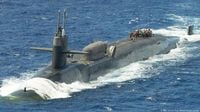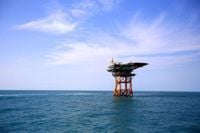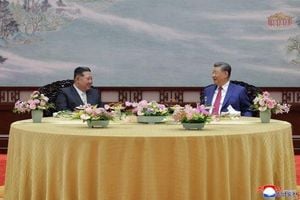In the swirling currents of Indo-Pacific geopolitics, the past week has seen a flurry of military maneuvers, technological revelations, and diplomatic maneuvering that underscore the escalating contest for regional supremacy. From the waters off South Korea to the coral-fringed islands of the South Pacific, the United States, China, Australia, and a host of regional players are rapidly recalibrating their strategies in response to shifting threats and alliances.
One of the most notable developments was the recent trilateral military exercise, Freedom Edge, conducted from September 15 to 19, 2025, by the United States, Japan, and South Korea. Held in international waters east and south of South Korea’s Jeju Island, this was the third such joint drill between the treaty allies, following earlier rounds in 2024. Significantly, it marked the first major exercise since US President Donald Trump and South Korean President Lee Jae-myung assumed office earlier this year, signaling a renewed commitment to collective defense in the region.
Yet, the exercise broke with precedent in a way that raised eyebrows among defense watchers: the United States did not send an aircraft carrier, a mainstay of previous drills. Some analysts, as reported by South China Morning Post, interpreted this as a subtle diplomatic gesture—perhaps an attempt by Washington to dial down the exercise’s visibility and avoid unnecessarily antagonizing China and North Korea. Others saw it as a reflection of the Trump administration’s push for greater burden-sharing among Asian allies in the face of China’s growing clout.
Nevertheless, the message from the US Indo-Pacific Command was clear. The exercise, it stated, “demonstrates the countries’ shared commitment to collectively achieve and maintain peace in the Asia-Pacific,” while actively addressing “shared threats” within the strategically crucial first island chain. As tensions simmer in the region, such joint drills serve as both a deterrent and a reminder of enduring alliances.
Meanwhile, China has been making waves of its own—both figuratively and literally. Last week, the South China Morning Post highlighted a groundbreaking study published in August by Electronics Optics & Control. The study revealed that the China Helicopter Research and Development Institute had engineered an artificial intelligence-driven anti-submarine warfare (ASW) system. In computer simulations, this system reportedly detected about 95% of even the stealthiest submarines, a feat that, if realized in practice, could upend decades of naval doctrine.
The AI system, developed under chief engineer Meng Hao, synthesizes data from sonar buoys, underwater microphones, and environmental sensors like water temperature and salinity to create a real-time, dynamic map of the underwater battlespace. Not only can it adapt to evasive maneuvers and decoys, but it also translates this torrent of complex data into actionable recommendations for military personnel. The vision for future iterations is even more ambitious: integrating with drone swarms, surface ships, and autonomous underwater robots to form a self-learning, three-dimensional detection network that could scan the ocean in real time.
Such technological leaps are not just about hardware—they’re also about psychological warfare. As the DW report noted, touting these breakthroughs serves to anchor the perception of Chinese strategic superiority, both at home and abroad. China’s recent assertiveness in the Taiwan Strait and South China Sea is part and parcel of this campaign. Gaining control of Taiwan would grant its submarine fleet coveted access to deep waters, bolstering its nuclear second-strike capability and complicating the calculus for adversaries.
Still, Western military experts remain skeptical about the immediate impact of China’s AI-driven ASW. Professor Paul S. Schmitt, a specialist in naval warfare at the US Naval War College, told DW that while AI can process vast sensor data and support decision-making, the underwater environment’s complexity poses formidable challenges. The cat-and-mouse game between submarine stealth and detection is far from over, and full integration of such AI systems remains a distant goal.
Beyond technology, the contest for influence in the Pacific is playing out through a series of high-stakes diplomatic initiatives. Australia, for its part, has redoubled efforts to cement its role as the region’s security anchor. On September 17, 2025, Canberra and Papua New Guinea (PNG) were poised to sign the Pukpuk Treaty—a mutual defense pact aimed at deepening military cooperation, interoperability, and integration. The agreement, which includes clauses to ensure that third-party engagements do not undermine treaty obligations (a thinly veiled reference to China), was ultimately deferred due to pending cabinet approvals in both countries.
This delay marked the second time in as many weeks that Australian Prime Minister Anthony Albanese left a Pacific nation without a signature on a key security deal. Earlier, talks with Vanuatu stalled over concerns that a similar agreement could impede Vanuatu’s ability to secure infrastructure funding from China, which has become a major financier in the region through its Belt and Road Initiative. Vanuatu’s hesitancy highlights the delicate balancing act many Pacific Island Countries (PICs) are performing as they weigh offers from both Canberra and Beijing.
PNG’s location is of particular strategic interest. Nestled between Taiwan and Australia, it could serve as a critical logistics hub and buffer zone in the event of a US-China conflict over Taiwan. The United States, in its strategic calculus, views PNG as part of the “second island chain,” a vital dispersal site for forces from more vulnerable bases like Guam. However, the current treaty stops short of obligating PNG to participate in any Indo-Pacific conflict, reflecting the country’s strong desire to protect its sovereignty—a sentiment echoed in recent protests against a similar defense agreement with the US.
Australia’s anxiety is rooted in recent history. The 2022 security pact between the Solomon Islands and China sent shockwaves through Canberra, raising the specter of a Chinese naval base just 2,000 kilometers from Australia’s east coast. Since then, Beijing has signed or pursued agreements with a string of Pacific nations, including Fiji, Kiribati, Samoa, the Cook Islands, and Vanuatu, seeking to extend its military footprint. In response, Australia has accelerated its own defense modernization and outreach.
Canberra’s efforts include ongoing negotiations for a new bilateral security treaty with Fiji, building on the Vuvale Partnership of 2023, and a recently signed climate and defense pact with Tuvalu. The latter includes a security guarantee and provisions for joint decision-making on Tuvalu’s external security arrangements, a clear attempt to keep Chinese influence at bay.
Australia’s military modernization is equally striking. Under the AUKUS pact with the US and UK, Australia will acquire at least three US Virginia-class submarines and eventually manufacture its own nuclear-powered subs. It has announced plans to purchase 11 Mogami-class frigates from Japan, invest in “Ghost Shark” underwater attack drones, and acquire an array of advanced US weaponry, including Tomahawk cruise missiles and hypersonic munitions. These moves, as noted by the EurAsian Times, are aimed squarely at deterring China’s expansion and maintaining a technological edge in the Indo-Pacific.
All the while, the global balance of underwater power continues to evolve. China now boasts the world’s largest submarine fleet, with 105 vessels, including at least six Jin-class and one Xia-class nuclear-powered ballistic missile submarines (SSBNs). The US, however, maintains the largest and most advanced SSBN fleet, with 14 Ohio-class boats and more than 50 modern attack submarines. Russia, the UK, France, and several NATO and non-NATO states also maintain significant, if smaller, underwater arsenals.
As the Indo-Pacific’s security environment grows ever more complex, the interplay of military exercises, technological innovation, and diplomatic jockeying will only intensify. For now, the region remains locked in a high-stakes contest—one where the balance of power can shift as swiftly as the tides.





